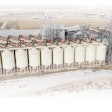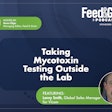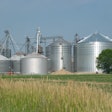In this episode of theFeed & Grain Podcast, Steven Kilger talks withJames Mintert,professor and extension economist for theDepartment of Agriculture Economics at Purdue University, about thePurdue UniversityandCME Group'sAg Economy Barometerand producer sentiment going into fall harvest.
Mintert discusses the history and methodology behind the Barometer as well as current producer sentiments on the state of the U.S. agriculture economy.
Transcript
Steven Kilger:Hello, everyone. Thank you for joining me. I'm Steven Kilger. I'm the managing editor of feeding grain and the host of the feeding grain Podcast. Today we have a great episode for you. James Mintert, a professor and extension economist for theDepartment of Agriculture Economics at Purdue University今天,是加入我谈论Ag)经济Barometer. If you don't know, the Ag Economy Barometer from Purdue University and CME Group, is a snapshot of how producers in agriculture are feeling at any given time throughout the year. They ask producers a series of questions about the ag economy and produce a monthly report going over how they're feeling. And it gives you kind of a good understanding about how the ag economy is looking at any given moment. So, without any further ado, thank you so much for joining me, James. Can you tell me a little bit about yourself.
James Mintert:I've been on the faculty here at Purdue since 2009. Prior to that, I was on the faculty at Kansas State for over 20 years, grew up in Missouri, our family farmed corn, soybeans, and wheat and the river bottoms just outside of St. Louis, and got two of my degrees here at Purdue bachelor's, master's here at Purdue, and then a Ph.D. at the University of Missouri before I went to Kansas State.
Kilger:Wow. So, you're well qualified to speak.
Mintert:I've been an ag my whole life, that's for sure. ag
Kilger:The Ag Economy Barometer is it's been one of my fascinations for the last couple of years. Now I get your monthly press release on how it's doing and covered a few times for our readers. But would you mind telling me a little bit about the history? And I wonder, where did it come from? What was kind of the genesis of this project?
Mintert:Yeah, so that's a great question. So, the genesis of the project was really instigated by the CME Group. And they really looked at the fact that there was no kind of a sentiment measure for US agriculture. And to back up a little bit, there are a number of sentiment measures for the US economy. The most widely circulated and perhaps the oldest and best known is the University of Michigan's Consumer Sentiment Survey. But there are other ones as well. So, there are surveys from the Institute of Supply Management. There's the Conference Board, there's a survey that surveys, mid-sized companies. So, there are a number of these sentiment surveys out there, but there was nothing focused on the agricultural sector. And more specifically, there was nothing focused on the ag producer sector.
And so, the idea was to come up with some kind of a sentiment measure for the ag sector. So, the CME was interested in pursuing that. They solicited proposals from a number of institutions, we were one of the ones that were solicited. And we submitted a proposal and was accepted. And our proposal was to emulate what the University of Michigan had done on the consumer sentiment side and apply that to the agricultural sector. And the more specifically the Ag producer sector. So that was the genesis, that was the idea was to do something in the ag sector, that kind of mirrored what Michigan had been doing for decades on the consumer side, and to see how it turned out. And we had no idea when we started how this would turn out. But it's turned out to be quite interesting.
Kilger:As producers go, a lot of the ag economy goes because they the biggest section of it. We get that question sometimes about like, well, why do you guys cover so much producer stuff? And really, it's because what producers are, they are the bedrock of our industry. And even though we're one layer removed, it's really important for us to understand where they're coming from.
Mintert:Well, they're the drivers of change. So, as you think about your sector that you're trying to cover, the folks that you work with are dependent very heavily on the decisions that producers make with respect to what they do with respect to crop acreage, input usage. On the livestock side, obviously, livestock numbers, livestock output. So, the fundamental decisions in the sector are being made at the producer level. And then other layers of the industry have to kind of respond to anticipate the changes are going to take place at the producer level.
Kilger:Yeah, even if it's how much storage am I going to have to allocate towards soybeans this year versus corn or something is basic as that, you have to know it before the crop arrives at your doorstep, ready to be stored. So, can you tell me a little bit about how you guys go about gathering the opinions of feelings of producers? What kind of data are you looking for? And is it a phone call survey? What do you do to gather that information?
Mintert:是的,所以结构是基于we're focused on commercial scale producers, the ag sector, if you look at the USDA data, they reported a huge number of farms, but it turns out that a real relatively small percentage of those farms actually produce the bulk of the nation's food. So, we target our surveys at those producers who really do produce the vast majority of us production. So, to do that, we use a stratified approach to our survey. So, we focus our surveys on producers who have an estimated gross farm income of $500,000, and up, and that's not terribly large by today's standards. But it's large enough that those folks are paying attention to the ag sector, it's an important source of their family's farm income and their family's total income, it might not be their sole source of income, but it's an important source. And so, from that standpoint, they're really focused on the business of agriculture. And those are the folks that we're trying to talk to.
The second thing we do is we focus on the producers of the major commodities. So, on the crop side, we focus on people that have a corn soybean enterprise, a wheat enterprise, and a cotton enterprise. And then the livestock side, we focus on people that have a beef enterprise, a pork enterprise, or a dairy enterprise, the main groups that we do not try and target our producers of specialty crops, especially livestock products, some of those folks wind up in our survey, but it's because they also produce one of those major commodities. So, in that sense, it really is representative of the vast majority of commercial production in the US. And we work with a large database. I think a lot of your listeners are probably familiar with this, that, you know, there's several providers of large databases of US farmers, we work with one of those, and it is a phone-based survey. And then the survey is scaled in a way that we use theUS Census of Agricultureto further identify the demographic mix that we want to be representative of US agriculture. So, we have targets for each of those enterprises in the monthly survey, minimum percentages we want to hit so for example, every month, at least 53% of the people in the survey have a corn or soybean enterprise, and so on down the line.
So, we have those demographic targets that we hit. And looking at the sampling and look at the accuracy that we're shooting for we aim for a plus or minus 5%. It turns out that given the relatively small number of producers that are in our target market, we're able to do that with a phone survey of 400 people each month.
And the one thing I guess I want to clarify, there's probably when I make presentations on the barometer, I think there's always some confusion about this. We don't talk to the same 400 people every month, we're randomly pulling names from that large database, and ensuring that we meet the demographic targets. So, the way we maintain consistency from one month to the next is by holding those demographic targets in place. That's how we maintain the comparability so you can compare one month to the next and one year to the last. so on down the line. That's how you maintain the comparability. So, we don't do it's not a panel. In other words, I think a lot of people, when they first hear about the Brahman, or they think it might be a panel, it's not a panel, we're talking to different people every month. And in fact, if you get a phone call from us this month, you're pulled out of the database, and we promise not to call you back for at least a year. So, in other words, your extract from the database, so we don't burn people out in that sense, I guess you're not going to get hit with this multiple months in a row.
Kilger:So it also keeps you guys from being getting the same opinions month after month.
Mintert:是的,我的意思是,有好东西做窗格ls surveys, and there's bad things about panel surveys, my personal experience is you burn people out pretty quickly. People, there's not very many people that really want to respond to a survey every single month. And that becomes problematic very quickly. So, by pulling people from that big database every month pulling new names every month, we've been able to keep things going. And then we allocate a week within each month to collect data. And we always publish that in the opening paragraph and say what week the data was collected. So, we'd normally start collecting data on a Monday and then finish up sometime on Friday.
Kilger:Are there regional parameters. Are you trying to get so many people from individual states? Because we know I mean, even crop conditions can vary greatly from depending on what part of the state.
Mintert:That's, that's a good question. We do not do that. And it's not that we wouldn't like to but to do that, we would have to have a much larger survey. So, we get that question a lot. A lot of times people want to know for example, a very common question is what can you tell us what's going on in the ice states? Indiana, Illinois, and Iowa? The answer is we cannot. We can tell you what, what we're picking up from corn and soybean producers, but we cannot narrow it down to any geographic region. And of course, there are corn and soybean producers outside those major producing states. And given the size of our survey, and that's a national scope, national database. We don't we don't sort based on those individual states or individual regions. I mean, I could do that within the database. But I would have no confidence in the accuracy because the numbers wouldn't be large enough, the responses wouldn't be large enough.
Kilger:We’re people who are constantly looking for new names, new contexts, new people in the grain handling and processing industry, it can be hard to narrow. There's sometimes less of them that people think that. So totally understand that. So, what kind of information? Are you asking producers when they do get this survey?
Mintert:Oh, so we have a set of five basic questions that we ask. So, the barometer itself is, is based on five questions that we really took from the University of Michigan Consumer Sentiment Survey. And we adapted them to agriculture. So, I'll just read them off to you.
Now, the first one says, would you say that your operation today is financially better off or worse off, or about the same compared to a year ago?
The second question is, do you think that a year from now your operation will be better off financially worse off, or just about the same as now?
The third one is do you think that during the next 12 months, there will be good times financially or bad times financially in the general agricultural economy?
And the fourth one is, do you think, during the next five years that US agriculture will have widespread good times or widespread bad times?
And then the fifth one is thinking about large farm investments, like buildings and machinery, do you think now is a good time or a bad time to buy such items?
And those if you look at the University of Michigan's Consumer Sentiment Survey, you can see that those questions parallel the same questions that they use to compute the consumer sentiment index. So, it really mirrors that. And then when we get people on the phone, we essentially promised to not keep them on very long. And our goal is to keep them on no more than five minutes to keep the survey pretty short. But it doesn't take anywhere close to five minutes to ask those five questions that I just read off to you. And so that gives us opportunities to ask other more contemporaneous questions. So, we can delve deeper into things like farmland values, you know, what's taking place with respect to changes in their cropping operation, you know, interest in, for example, cover crops? Are you using cover crops? Are you not using them? Why etc.
So, we ask a lot of those kind of more contemporaneous questions to kind of dig a little deeper into what's going on and what people are thinking about what they're worried about. So, one of our challenges every month, is to think about what additional questions do we want to ask. And now that we've been doing it for several years, we always look at what we did this time last year, and try and build some continuity there with respect to what kind of change are we picking up this year versus last year? And then, of course, you know, some very contemporaneous things come up.
So for example, you know, I think, last couple of surveys, we've been asking questions about things like cover crops, for example, cover crop usage, we've been asking questions about solar leasing, of farmland, so some contemporaneous things like that we asked about, you know, when things were hot and heavy with China, we were asking about people's perspective on trade with China, and what they thought so really gives us an opportunity on a monthly basis, to really kind of put our finger on the pulse of us ag producers, in a way that I don't think anybody else really has the opportunity to do. So, we're very grateful for the funding that we get from CME Group that allows us to do this because it's not, it's not a cheap enterprise. And that's why other people aren't able to do it. But they're able to, they've been funding that for us. And it really gives us an opportunity to, to tap into what people are thinking about, and what's influencing their behavior.
Kilger:Especially you get to kind of talk about those hot button issues, which is someone who has to cover up hot button issues. That's, it’s kind of a dream, right to be able to have those direct sources every month to figure out what people are thinking.
Mintert:Yeah, it really is. And it's our challenge is to phrase questions in a way that people can answer them easily on a telephone survey. There are some issues there are some limitations and we've kind of learned how to work with those. But you know, third times when you come up with some ideas of things you want to ask, but you can have trouble formulating and in a way that it's easy to ask and for people to respond on a telephone I'm without going into very long discussions.
Kilger:Yeah, that's the challenge, right to get it to be more than a yes or no answer, but not I'm going to have someone rant about how they feel about this.
Mintert:Yeah, I mean, it that is a very interesting aspect of it, and then at the end, so we typically have somewhere between 20, maybe as many 30 questions, but usually, if there's 30 questions, they're structured in a way that not every person on the survey would be wound up answering those. Yeah, we do ask, okay, we've just asked you a lot of questions, if there's something else that is on your mind that you would like to share with us.
So that's wide open, and the interviewers simply type in whatever people say. And so those comments are quite interesting, we use that to generate a word cloud to just get a little idea as to what's on people's minds. So that does provide that open ended question that you can use to kind of measure a little bit about the change. And you can kind of see some of the hot button issues kind of floating to the top and those word clouds, you know, when open ended questions are always difficult to tabulate, and really draw any inferences with respect to what people are talking about. So, the rest of our questions are always formulated in a way where we can tabulate them and report back in terms of the percentages that people feel, you know, positive or negative about, etc. So, two ways of looking at it, but we do to have that aspect of it. And it is interesting to look at those word clouds.
Kilger:Yeah, yeah. Well, and you have to be respectful of people's time, if you tell them it's going to only take five minutes can only take five minutes. And as someone who now gets political polls, message to them every day, it gets exhausting.
Mintert:Yeah. And then of course, there are people that hang up. You know, that's one of the challenges, but it's also one of the good things about a phone surveys that you can just keep calling. And that's what the callers do is they keep calling until they hit our demographic targets every month.
Kilger: Producer sentiment rose a little bit in August. It's been kind of an, it's been a weird couple of years. But everything world events are beyond our control. But things are a little better in August. What are kind of the main issues that you see, you're still kind of concerning producers out there. What are they thinking about right now?
Mintert:Well, I think we're picking up something in the ag economy barometer index, that's also showing up in the consumer indexes. And that is anxiety. People are very anxious about where they're headed. And to some extent, the current situation, because if you look at our barometer index, this past month, it was at a rating of 117. The month earlier, it was 103. And if you go back two months, it was at a low point of 97. If you go back about a year and a half, that index was up above 175. So we've seen a tremendous loss of confidence among producers since late 2020, early 2021. With just the modest recovery that you mentioned at the outset here, this last month or month and a half. And so you know what's driving that?
Well, it's uncertainty and anxiety about what it's going to cost to put a crop in the ground or to raise livestock. It's uncertainty about availability of inputs. We've had a significant percentage of respondents over a period of several months, telling us they're worried about availability of inputs. I've been in agriculture for close to 50 years now. And there are very, very few times in agriculture where you had to worry about the availability of inputs. You worry sometimes about the price, but you didn't really worry much about Could I get fertilizer? Could I get seed? Could I get herbicides? Can I get parts for farm machinery? That level of uncertainty is being expressed, I think, by producers in the lack of confidence that they're showing. And I think on the consumer side, we're picking up the same kind of thing. If you look at the University of Michigan's Consumer Sentiment Survey, they're picking up the same kind of issues. So that it's that level of uncertainty.
I always tell people in agriculture producers are acclimated to volatility in output prices. They know that corn and soybean prices can fluctuate. They know that prices for hogs for beef cattle. Milk can fluctuate fairly dramatically over a period of off sometimes within a period of a year. What they're not acclimated to though, is this uncertainty about input prices because normally they're not that volatile. They're not acclimated to this uncertainty about availability. And then more recently, I guess we'll see other upcoming surveys, but I suspect we're starting to pick up a little bit of concern about interest rates. And on our last survey, it wasn't a big deal, but it was starting to show up a little bit, I think that'll be an issue going forward. So that's, that's really the what's making the sentiment weaker than you might expect.
Given the fact that especially for crop producers, especially for corn and soybean producers, which are large portion of our survey 21 was a very good year 22 is going to be a pretty good year for most of those folks. And if you just look at the income levels, you'd think sentiment would be more positive than it is showing up on our surveys. But I think it said uncertainty about what's taking place. And when I have individual conversations with producers, I'm picking up the same thing.
One of the first things people ask me, we do a farm management tour every summer here at Purdue. And when I was doing the interviews, getting ready for those farm management tour visits, one of the first questions the producers were asking me was, well, what do you think's going to happen with this was the back in April of 22. And they were asking me about what I thought it was going to put cost to put a crop in the ground, and 23 other words, they were already looking to the next year. That's unusual. And I think that's reflective of the uncertainty and the risk that people feel like they're facing.
Kilger:Yeah, definitely. And well, I mean, all in all throughout your entire process, right? Even if you're going to dry your own grain this winter, you're going to have to start worrying about propane prices.
Mintert:Yeah, what's it going to? What's it going to? What's it going to cost? Yes, exactly.
Kilger:That's, it's really interesting, and especially how it’s kind of sometimes it. Well, in this case, it appears that Consumer Index, which we're all we're all a little scared about. Anxiety is almost universal.
Mintert:If you look at the commodity markets, for example, I mean, I open up my email in the morning, like a lot of producers, and I get several different emails, kind of summarizing what happened overnight and the commodity markets, what are the opening comments about? There are there about what's going on in Ukraine? Right? What's the status of the war? What's Putin going to do? Or not do? Is the Black Sea open or not open? These are not things that we normally worry about. But we are now right. And I think that's showing up on our surveys.
Kilger:当它用于像,你知道,黑海green trade doing really, it wasn't huge. on everyone's mind, but now Yeah, with that more, it's seems to be the half the headlines you see now about commodities and commodity prices are based on what's going on in Ukraine, it's part of about being in a global economy, right is, even if, technically, there's no grain shortage around here, it's still going to affect everything that we do.
Mintert:Well, I think what a lot of us, maybe weren't acclimated to was how much more important grain production, especially corn production coming out of that Black Sea region had become over the last roughly 15 years. 15 years ago, what happened in Ukraine, with respect to corn wasn't a big deal. It is now that's reflective of what's happened over there. Truthfully, it's reflective of the fact that the Ukraine economy had the opportunity finally, over the last couple of decades to respond to market forces. And when that happened, they became much more productive, they started using current technology, which meant better seeds, you know, better genetics meant better fertilization programs, better machinery, expansion of acreage, all of a sudden, you know, over the course of about a decade and a half, Ukraine became a major corn producer, whereas, you know, you go back to like 2006, 2007, they were still pretty small.
Kilger:Are there? Is there a seasonality with the barometer? So, you find that people tend to get a little more worried in the spring in the fall during harvest, and then, or is it pretty steady throughout the year?
Mintert:That's a good question. And I'm going to duck it because we don't really have enough data to answer it. Since we've only been collecting data since the fall of 2015. At this point, we just simply don't have enough data, enough observations to really make any kind of definitive statement about seasonality. It is something we're keeping an eye on. My kind of standard response to that question is, we probably need at least 10 years of data before I can really say anything about seasonality with any confidence. But it is a question that comes up. I mean, I've you're not the first person that's asked me that. But we simply need more observations before we can say anything definitive about seasonality.
Kilger:I mean, that's a good scientific answer. You want more data, and I understand that because it just in my layman's terms, I'd be like, Yeah, well, I'm paying for the seat, that's when I'm most concerned. But even in your observations where people are already concerned about 2023, I mean, obviously they are thinking so I'll have you on again in three years and hopefully.
Mintert:There you go. What I would say is looking at data, there might be some seasonality in it. We don't have enough data to answer that question. But our experience has been that exogenous factors, things outside the ag sector that are impacting the ag sector are seemed to be having a bigger influence. I mean, one of the things that that popped up, and we didn't really expect, because it was early days with respect to collecting data, was the fact that politics affects the barometer. If you look at the results, just before the 2016 election, and then following the 2016, election, there was a huge swing and sentiment, and it was clear that presidential election had the impact. We did follow up questions to figure out, you know what the change was, and people were telling us things like they expected a more favorable tax policy, they expected a more favorable trade policy. So, they expected more favorable environmental policy. And we saw not quite as large a response, but we saw response from the 2020 election. So those outside factors influence people's sentiment.
我总是告诉人们,这是一个信心指数。It's not a direct measure of people's financial well-being. You know, when we call people up, we asked him, what do you think we don't say, go look at your income statement, go look at your balance sheet. They don't do that. They just tell us how they feel. So, it is a sentiment index. And that sentiment index is a little different than saying, well, you know exactly where you're at financially, we get a feel for where they think they are financially. But we don't actually delve into the mechanics of exactly what is your income statement look like? Or what is your balance sheet look like? It really is a measure of their sentiment in terms of how they feel about these things.
Kilger:Yeah, that's a really good point. Well, I remember, you know, reading interviews back when the trade war with China really started and you'd have guys that well, like, yeah, this will ruin me, but it's good for the economy. So, it's really hard to, you know, divorce that what's right for me versus what I feel politically and overall.
Mintert:Yeah, and you get different responses from individuals. And of course, that's the nice thing about a survey where you are able to aggregate those and kind of measure, you know, what's the overall perspective? Because within the individual responses, you do get some diversity?
Kilger:Yeah, I'd imagine it's, that data nerd in me really wants to see those responses. Thank you so much for taking the time to sit down and talk with me and let us know a little more about the ag economy barometer, because like I said, it's one of the most, if people are, if listeners are getting it, they will have a link in the show description, and then the eventual transcript that comes out to it, because it is kind of one of those nice little steps like, oh, just what's the base? What's the mood of our industry in general?
Mintert:是的,这是一个很好的观点。当然,这是联邦e. If your folks are interested, they can get a email from us once a month, when the browser comes out, we send an email out that kind of summarizes the results. And then there's a more detailed report that actually contains all the charts, etc., that you can look at and a little more detail.
Kilger:No, it is very valuable to the industry. So, I would encourage everyone to at the very least check it out. James, thank you again, so much for talking to me, and I'll be sending a calendar invite for three years when we can talk about seasonality.
Mintert:Sounds good. Thanks, Steven. Catch you later.



















